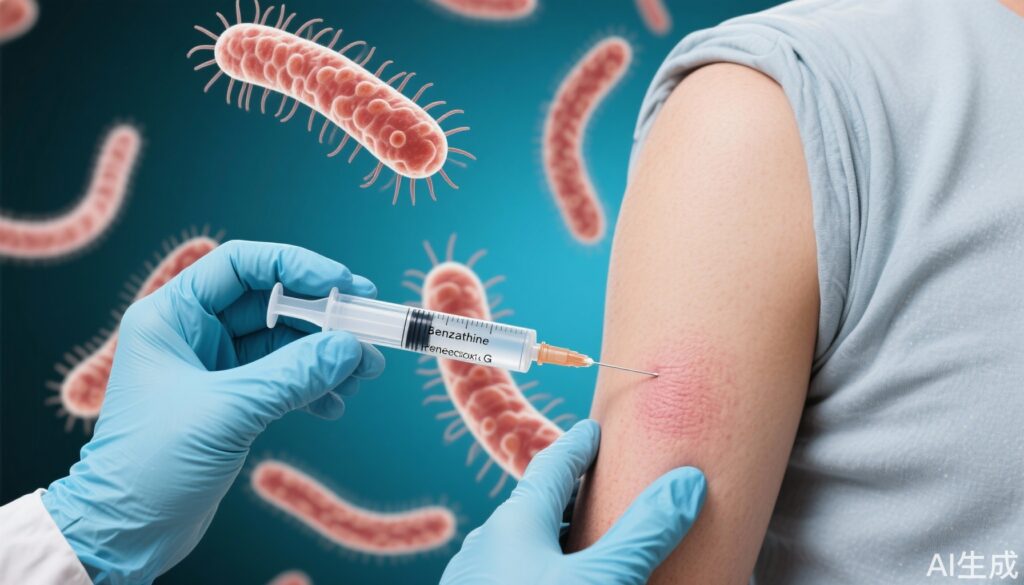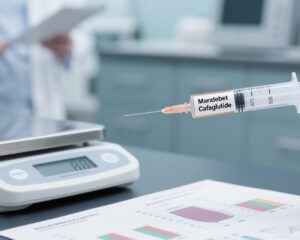Highlight
- Single-dose benzathine penicillin G (2.4 million units) in early syphilis is noninferior to three weekly doses regarding serologic response at 6 months.
- Effectiveness is consistent in patients with and without HIV infection, indicating broad applicability.
- Both regimens were well tolerated; however, local injection-site pain was more common with three doses.
Study Background and Disease Burden
Syphilis, caused by the spirochete bacterium Treponema pallidum, remains a significant public health challenge worldwide. Despite effective antibiotic therapy available for decades, incidence rates of early syphilis—including primary, secondary, and early latent stages—have resurfaced, particularly among men who have sex with men and populations with high HIV prevalence. Early and effective treatment is crucial to prevent late complications such as neurosyphilis and cardiovascular involvement.
The current Centers for Disease Control and Prevention (CDC) guidelines recommend a single intramuscular injection of 2.4 million units of benzathine penicillin G for early syphilis. However, some clinicians use three weekly doses, especially in persons living with HIV, due to concerns about treatment failure and slower immunologic response. This variability in practice reflects an ongoing controversy regarding optimal treatment duration to maximize efficacy while minimizing morbidity and healthcare burden.
Study Design
This investigation was a multicenter, randomized, controlled, noninferiority trial enrolling 249 individuals with early syphilis. Participants included men (97%), with 62% self-identified as Black, and 61% living with HIV infection. Syphilis was categorized as primary (19%), secondary (47%), or early latent (33%) based on clinical and laboratory criteria.
Subjects were randomized to receive either a single intramuscular dose of 2.4 million units of benzathine penicillin G or three weekly doses of the same amount. The primary endpoint was a serologic response at 6 months, defined as either seroreversion to a nonreactive rapid plasma reagin (RPR) test or a reduction in RPR titer by at least two dilutions.
A noninferiority margin of 10 percentage points was pre-specified, with a key secondary endpoint analyzing serologic response stratified by HIV status to assess whether treatment efficacy varied by coinfection.
Key Findings
At 6 months post-treatment, 76% (95% CI, 68 to 82) in the single-dose group and 70% (95% CI, 61 to 77) in the three-dose group achieved the primary serologic response. The difference of -6 percentage points (90% CI, -15 to 3) met the noninferiority criterion, confirming that one dose was not clinically worse than three doses by a meaningful margin.
Subgroup analyses revealed consistent serologic response rates regardless of HIV status: 76% in HIV-positive and 76% in HIV-negative participants in the single-dose arm, compared with 71% and 70%, respectively, in the three-dose arm. This suggests that immune compromise related to HIV did not adversely affect treatment efficacy.
No clinical relapses or treatment failures were observed during the 6-month follow-up. Adverse events primarily involved local injection-site reactions, reported by 76% of participants in the single-dose group versus 85% in the three-dose group, indicating a higher local discomfort burden with repeated injections.
Expert Commentary
This rigorous randomized trial provides compelling evidence supporting single-dose benzathine penicillin G as an effective and well-tolerated treatment for early syphilis, including among persons with HIV. The findings challenge some clinicians’ preference for extended therapy in coinfected patients.
The trial’s strengths include randomized design, robust sample size with substantial HIV representation, and clinically meaningful endpoints based on established serologic markers. However, the predominantly male and Black study population may limit generalizability to women or other demographic groups.
While the trial’s 6-month follow-up is clinically appropriate for early syphilis response, longer-term outcomes would further validate durability. Additionally, the study did not routinely perform direct detection assays or neurosyphilis evaluations, but absence of clinical relapse supports the adequacy of therapy.
The results align with existing CDC guidelines endorsing one dose for early syphilis and provide strong evidence to reduce overtreatment. This benefits patients by minimizing injection discomfort and healthcare systems by lowering resource utilization.
Conclusion
In summary, this study confirms that one intramuscular 2.4 million unit dose of benzathine penicillin G is noninferior to three weekly doses for treating early syphilis, irrespective of HIV status. Adoption of a single-dose regimen could standardize care, reduce patient burden, and maintain excellent clinical outcomes.
Future research should investigate long-term clinical effectiveness in diverse populations and explore biomarkers to better predict individual treatment response. Meanwhile, clinicians can confidently utilize a single-dose strategy in most early syphilis cases, streamlining management without compromising efficacy.
References
1. Hook EW 3rd, Dionne JA, Workowski K, et al. One Dose versus Three Doses of Benzathine Penicillin G in Early Syphilis. N Engl J Med. 2025;393(9):869-878. doi:10.1056/NEJMoa2401802
2. Centers for Disease Control and Prevention. Sexually Transmitted Diseases Treatment Guidelines, 2021. MMWR Recomm Rep. 2021;70(4):1-187.
3. Ghanem KG, Ram S, Rice PA. The Modern Epidemic of Syphilis. N Engl J Med. 2020;382:845-854. doi:10.1056/NEJMra1903794



